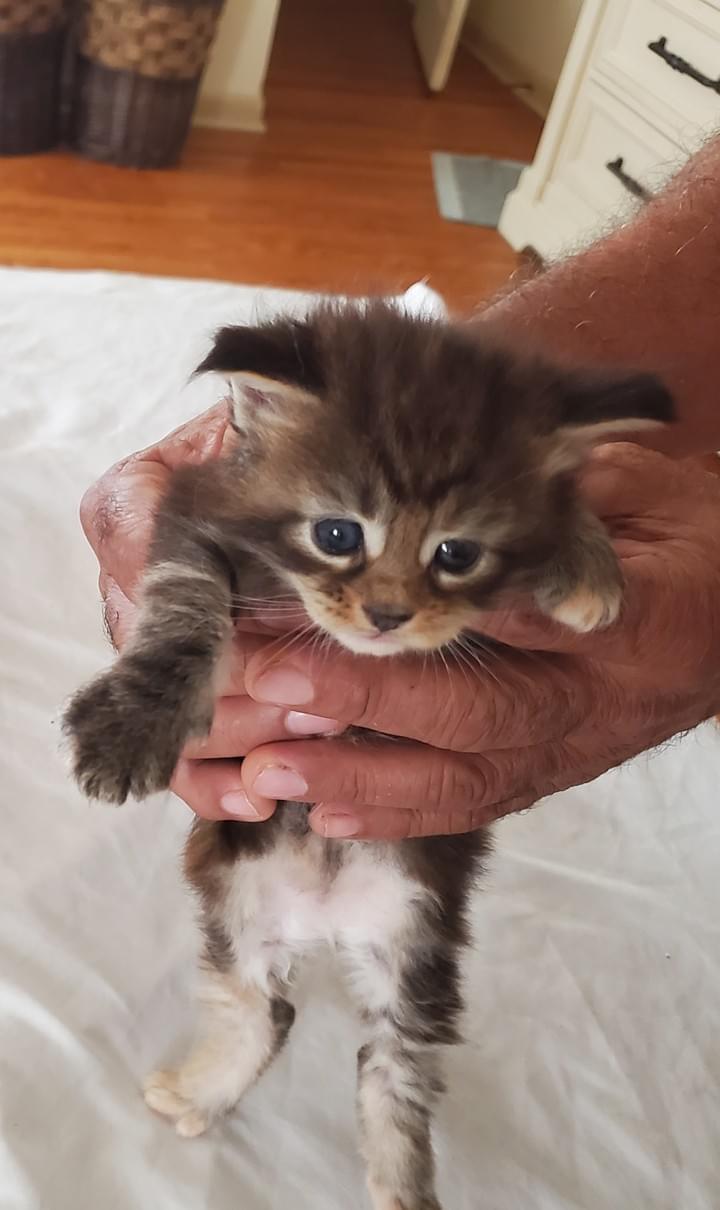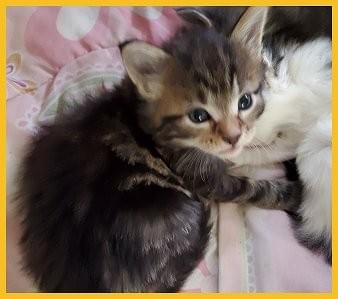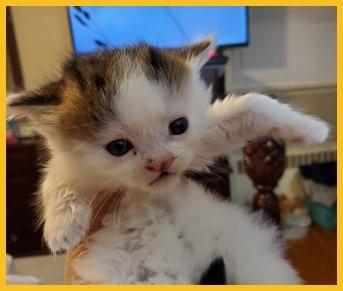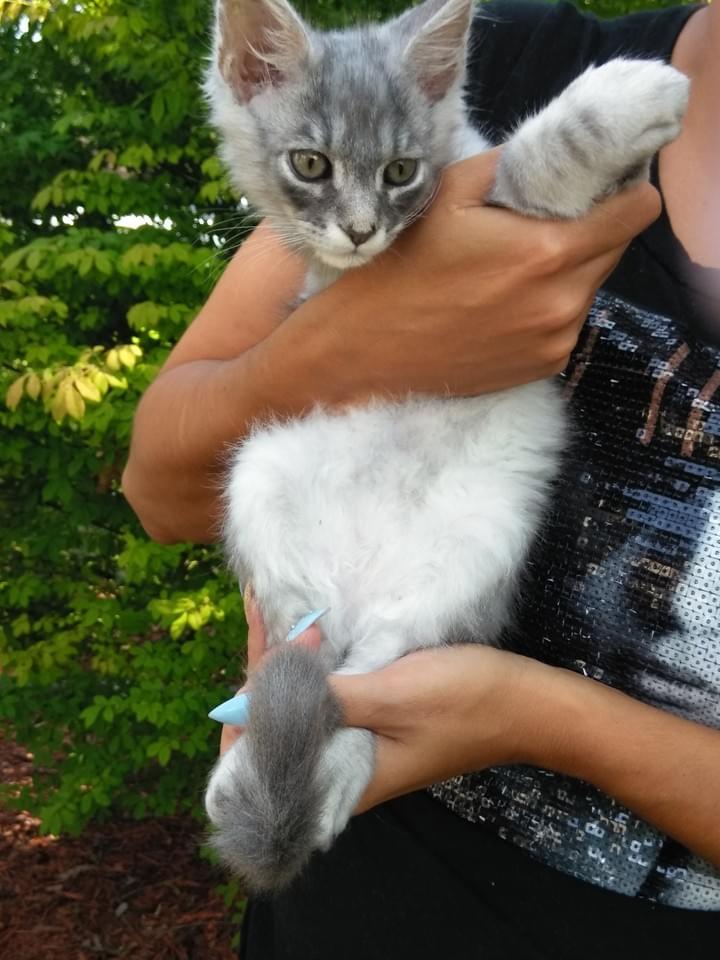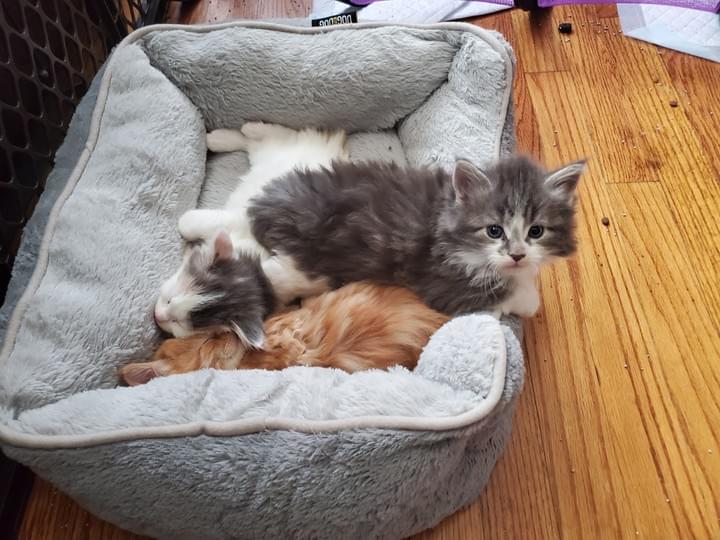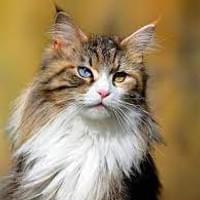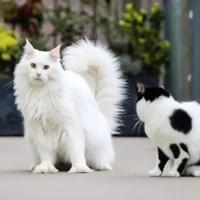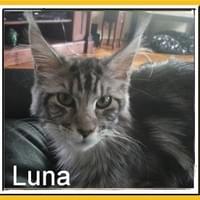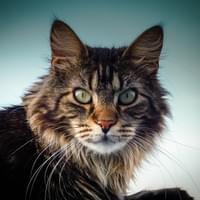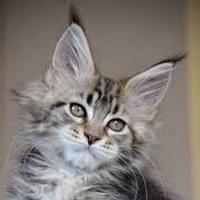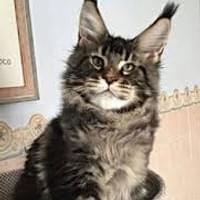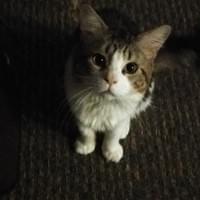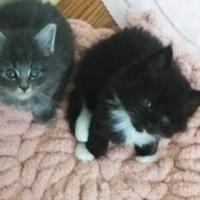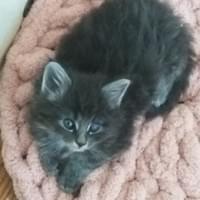



Breeder
Elisa Medina
99 Moran Street
Waterbury, CT
06704
- …



Breeder
Elisa Medina
99 Moran Street
Waterbury, CT
06704
- …


Shadowlynx
Maine Coon Cattery
Shadowlynx646@gmail.com
Best way to contact us is through email. We will not answer texts or phone calls for now. Sorry for the inconvenience.
We have downsized our cattery. We're keeping
three new queens and only
Kasper as our stud for now. Our new girls are Eva (Black Silver - Luna's daughter, Ivana Black Tortie mitted from Anya Carson's cattery and Misty (silver with shaded lines)
Thank you for your interest in
This is a CFF and CFA certified cattery.
Our breeding cats are part of the Wellness Program at Banfield Vet Hospital and are checked every 6 months. They are tested for FeLV (feline leukemia) and FIV (feline immunodeficiency virus yearly. They get a whole physical check up every 6 months.
APPLICATIONS WILL BE SENT VIA EMAIL!!
Please visit Banfield.com for a wellness program for your new kitten.
About Us
ats. They are raised in our home with us and we strive to breed healthy, well socialized and happy cats. Our cats have a large cattery and outside enclosure where they can enjoy the outdoors in a protected environment. They are checked by my vet at Banfield Vet Hospital as part of their Wellness Program every six months.
We are a small home based cattery located in Waterbury, CT. I am a retired school teacher and my passion are my cats. They are raised in our home with us and we strive to breed healthy, well socialized and happy cats. Our cats have a large cattery and outside enclosure where they can enjoy the outdoors in a protected environment. They are checked by my vet at Banfield Vet Hospital as part of their Wellness Program every six months.

Our Queens
Our adorable girls
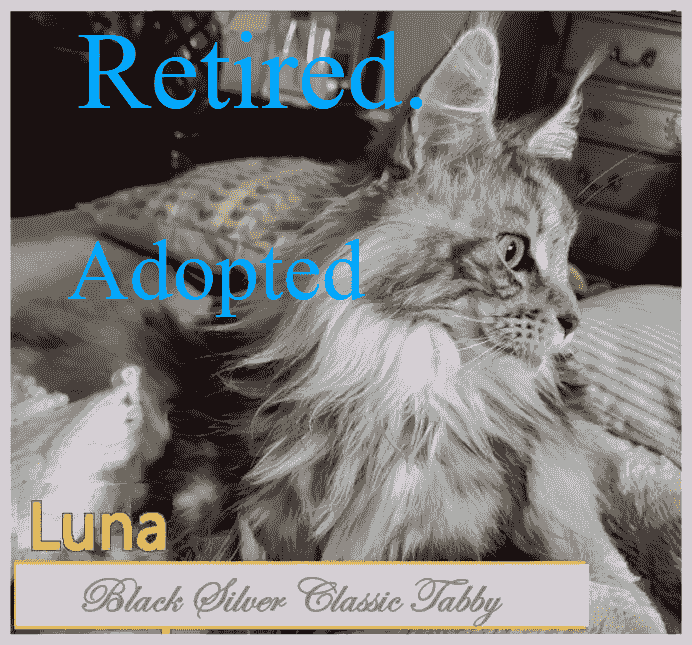
Luna
Silver black
Lune came to us from Rome, Italy
Cattery - Stars of Monaco
PARENTS

Ellie
Torbie
came to us from
Pinecoonz
Maine usa
PARENTS
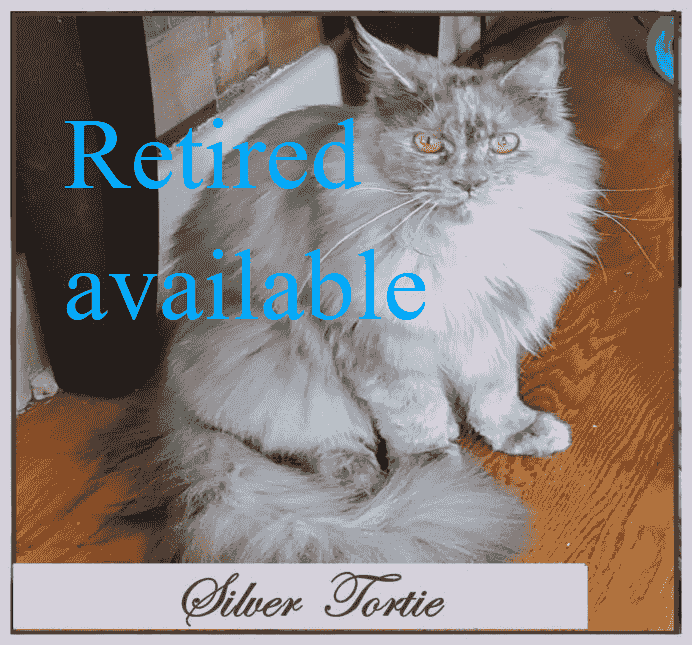
Sasha
Beautiful
Silver Tortie
Came to us from Ukraine
Wooten Cattery
Olga Mishalova
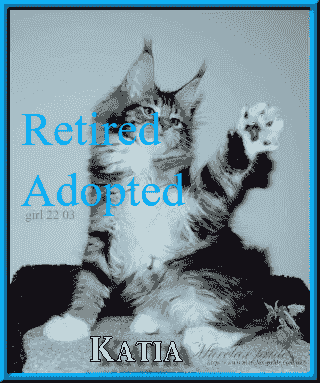
Katia
This is katia from Russia.
She comes to us from Irina marshalova
Maralex cattery
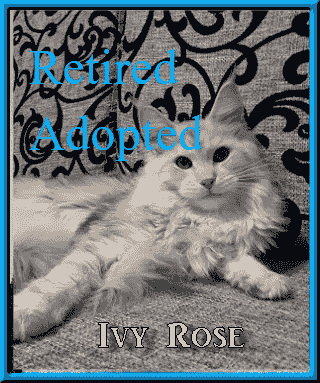
Ivy Rose
This is Ivy Rose. Our new Russian breeding queen from Natalya Kaponitsa. She's a gorgeous cream girl with white!

Ruby
Diluted Calico
She is Rex and Ellie's daughter
Shadowlyx Girl

Our Kings
Our big boys

Romeo
Black Brown classic tabby. Came to us from
Dreamcoons
Virginia

Logan
Red classic
came to us from
Pinecoonz
Maine

Kasper
Silver ticked with shaded lines
came to us from Irina Marshalova
Poland/Ukraine
Please remeber that you're kitten is cute now, but at 2 years of age, he/she will be gorgeous.
About This breed
The Maine Coon is a long-haired breed that is native to Maine, where it has been held in high regard for its mousing talents for centuries.
Physical Characteristics
The Maine Coon is one of the largest domestic cat breeds, though it is slow to physically mature. Typically the Maine Coon will not reach its maximum size until it is about 3 or 4 years old. It has strong build with a broad chest and a long rectangular body shape. Its head is triangular with wide-set eyes and large ears, and its tail is long and plush.
COLOR(S)
The Maine Coon can be seen in a wide variety of colors and patterns, excluding chocolate, lilac, and Siamese point patterns.
COAT
The coat of the Maine Coon is long in length and heavy in weight; it is also water resistant.
Personality and Temperament ACTIVITY LEVEL
Low to Medium
POSITIVES
The Maine Coon is a gentle cat breed with an easygoing personality. It gets along with kids and other pets, and makes a great mouser.
THINGS TO CONSIDER
In addition to grooming the Maine Coon’s coat twice a week with a steel comb, you will need to be sure to provide opportunities for regular daily exercise, often in the form of play. Although it is wary of strangers initially, it will grow accustomed to them if given time.
Care IDEAL LIVING CONDITIONS
This hardy breed can adapt to a variety of living conditions. It is docile, obedient, and, curiously, attracted to water. So don’t be surprised if you see your Maine Coon taking a little dip.
SPECIAL REQUIREMENTS
In order to prevent matting, the breed requires regular grooming.
Health
The Maine Coon is no more prone to a condition than any other cat breed.
History and Background
Maine Coons have inhabited America for centuries, even during the early colonial period. However, there is very little knowledge of how they first came to the continent. There are many tales related to trace their origin, though the authenticity of these tales is doubtful.
One far-fetched story claims that the breed’s ancestor was a raccoon – which is biologically impossible. Others say the breed was produced by the crossing of the indigenous Bobcat with a domestic cat. Yet another fanciful tale traces their ancestry to the long-haired cats belonging to the French queen, Marie Antoinette. According to this lore, an American captain named Clough rescued the queen’s cats but was unable to save her life; the cats were then brought to America. Yet another narrative is that these cats were brought to the states in the 1700s by an American captain named Coon, who hailed from the Northeast coast of America.
This last tale may contain some grains of truth. Captains of ships often brought cats from foreign lands to counter the problems of mice, which thrived on the ships. On their arrival they may have made their home on the Northeast coast, in Maine. The climate was terrible and only the bravest and toughest cats could survive. The survivors were strong and hardy with a water-resistant coat.
The Maine Coon is one of the first breeds to be officially recognized in the early 19th century; since then it has gained rapid popularity. Mr. F. R. Pierce, who owned Maine Coons as early as 1861, mentioned in The Book of the Cat that a Maine Coon named Leo was awarded Best Cat in the New York City cat show of 1895 and was a consistent winner in Boston in 1897, 1898, and 1899.
The breed’s popularity plummeted in the early 1900s when more exotic cats arrived and became instant favorites. By 1950, the breed had dwindled alarmingly and very few members were left.
A few breeders, however, displayed an active interest in this cat and threw it a life line. They held Maine Coon-only shows and in 1968 founded the Maine Coon Breeders and Fanciers Association.
Thanks to the efforts of its staunch supporters, the breed regained much lost ground and was once again a candidate for Championship competitions. It remains one of the most popular breeds of cat today, with Championship status in all associations.
Article from:
We have three litters available. Please contact us at emedina203@gmail.com

torbie sold

torbie wih high white
sold

Black Brown classic tabby
Reserved
sold

Male bicolor with slight hairlip
500.00
white with black spots
stays witu us

past litters

past litters

past litters
Your New Kitten
When you welcome your inquisitive new kitten into your home, she’ll probably take a little time to get used to her new surroundings. It’s best to let your kitten explore, and discover things in her own time. Even so, there are still plenty of things you can do to help your kitten settle in.
Which room?
Decide which room your kitten will live in for the first few days. Make sure the room has a door or some other way of shielding your kitten from the hustle and bustle of daily life, including children and other pets.
High places and hiding spots
In the wild, your kitten’s big cat cousins like to patrol their territory from a high vantage point. This keeps them out of the way of predators, and helps them spot potential prey without being seen. If possible, choose a room where your new feline friend can hide easily, and where she can get up high. By encouraging your kitten to recreate this kind of natural behaviour, you’ll help her settle in more easily.
Litter tray
Cats naturally choose a quiet, secluded place to go to the toilet. So it’s a good idea to place your kitten’s litter tray in a corner opposite the door. Don't forget to have tray liners and a scoop ready, and remember to clean out the tray regularly. Cats like to keep themselves clean, and if the tray is dirty your kitten will probably choose to go somewhere else!
Food and water bowls
In the wild, big cats never eat in the same place as they go to the toilet. So it makes sense to position your kitten’s food and water bowl as far away from the litter tray as possible. Your cute little kitten will also thank you for using shallow bowls, because the low sides won’t bang her sensitive whiskers.
Cat basket
Cat baskets should be comfortable, warm and easy to clean. If you do provide one for you kitten, however, don't be surprised if she makes her own choice about where to sleep. That independent nature is just one of the many things you'll grow to love about your new feline friend!
Cat carrier
You'll need a cat carrier not only for your kitten’s first journey home, but also for later trips, such as to the vet or cattery. There's a wide range of different types available, so pick the one that you and your kitten are happiest with.
Scratching posts
Scratching is a natural behaviour. It keeps a cat’s claws in good hunting condition, and also creates both scent and visual signals designed to mark territory. Give your kitten a scratching post, and watch her exercise her instincts just as nature intended!
Other useful things
• Grooming equipment suitable for your breed
• Cat flap
• Fast-release collar, lead, name tag and bell
• Toys
Settling in
When you first bring your kitten home, keep the house as quiet as possible, and don't be surprised if she starts out a bit timid. Show your kitten where her room is, and let her explore by herself. Leave a door slightly ajar so your kitten can come and go as she pleases. Your new arrival will soon let you know when she’s ready to explore a little further.Article at:
https://www.whiskas.co.uk/kitten/care/bringing-your-kitten-home

Kitten prices and health guarantee
Pet quality kittens - All kittens are 2,200.00
silver kittens with shaded lines have higher cost because of rare color.
All shaded lines silver black are 2,300.00
Show quality and breeding cat will be double the price of kitten.
Prices will be posted under available kittens page
Prices are determined by color, size, show cat quality and pedigree.
You can reserve your kitten with $600.00 which will go towards final balance. All deposits are non refundable unless you contact me that you no longer want kitten within thirty days of purchase. After 30 days, I will refund only half deposit.
If you are interested in placing a deposit for a kitten that is currently pictured on the web site-kitten info page as available, please Contact Me by e-mail or phone before sending a deposit. Once any and all of your questions are answered, if you desire to place a $1500 nonrefundable deposit and complete the contract data, just follow the instructions on the Sales Contract Page.
All kittens are sold as indoor pets only with a (required) spay/neuter agreement, unless breeder decides to spay/neuter kitten before sending in to its forever home. If you're interested in purchasing a show quality kitten for breeding, please contact me.
Kittens are allowed to go to new homes at a minimum of 12 weeks of age and they will have had all required shots except for a rabies shot, plus tested for FELV & FIV.
Health Guarantee
Kittens are sold with a written 2 year health guarantee. The guarantee covers any birth or genetic defect that would negatively impact the kittens life, if the defect occurs during the first 2 years. If one does occur, you are required to have a veterinarian document that the issue is something that the kitten was born with. Upon receipt of documentation, I will either refund your purchase price or replace the kitten with one of equal quality. And you still keep the original kitten.


Vaccines Kittens Need
Core vs. Non-core
- Core vaccines: Some infectious diseases are so common, debilitating/devastating, easily spread, and/or able to be spread to people (“zoonotic”) that it’s critically important to vaccinate all cats. These core vaccinations are strongly recommended, regardless of your cat’s location, lifestyle, history, etc. The core vaccines for cats are described in the table below.
- Non-core vaccines: On the other hand, some vaccines are only needed depending on conditions that are specific to your cat, their lifestyle, or their environment. If certain risk factors apply to your cat, your vet might recommend one (or more) of these non-core vaccinations. These vaccinations aren’t needed for all cats, but are important and beneficial to some. The non-core vaccines for cats are described in the table below.
First-Year Kitten Shots
Many of your kitten’s initial shots will be given as a series of “boosters” every 3–4 weeks. To achieve the best protection possible, your kitten will need boosters over the first several months of their life, at least until they are between 16–20 weeks old. And even adult cats will need an initial series of shots and boosters for certain vaccinations to achieve the best level of protection.
Year 2 Vaccinations and Beyond
After the initial series in that first year, it’s still important to keep an adult cat up-to-date on vaccinations so they are fully protected from disease. Most of the vaccines above need to be boosted again at the 1-year mark, after which the frequency of re-vaccination may change, based on the vaccine itself (its reported “duration of immunity”) and all of the cat-specific factors outlined above.This is just one of the big reasons why it’s so important for your cat to have a regular wellness exam with your vet each year. (And here are 5 non-vaccine reasons why wellness exams for cats are important.) During these visits, your cat can get any vaccine boosters they need and you can talk to your vet about additional vaccines your cat might benefit from. Additionally, you can ask about vaccines that can be discontinued depending on any changes in your cat’s health, lifestyle, home environment, and all of the other factors listed above.
Regarding your cat’s vaccinations — and overall health and needs — you should make sure to let your vet know if any of the following changes have occurred since your cat’s previous wellness exam, or will be occurring within the next several months:
- You’re moving to a different part of the country
- You’ll be traveling with your cat to a different part of the state, or out of state
- You will be boarding your cat in a kennel, cattery, or in someone else's home where there are other cats
- You’re getting, or have gotten, another cat
- You’re letting your cat go outdoors for the first time or letting them spend more time outdoors
- Your previously outdoor cat is now indoors-exclusively
- Your cat has been involved in a cat fight
Article from: https://www.preventivevet.com/cats/kitten-shots-what-vaccines-your-new-cat-needs-and-when

- Core vaccines: Some infectious diseases are so common, debilitating/devastating, easily spread, and/or able to be spread to people (“zoonotic”) that it’s critically important to vaccinate all cats. These core vaccinations are strongly recommended, regardless of your cat’s location, lifestyle, history, etc. The core vaccines for cats are described in the table below.
Declawing your cat. Don't!
Declawing cats: Far worse than a manicure
Instead of declawing your cat, try our effective, humane methods for resolving scratching issues. People often mistakenly believe that declawing their cats is a harmless "quick fix" for unwanted scratching. They don't realize that declawing can make a cat less likely to use the litter box or more likely to bite. Declawing also can cause lasting physical problems for your cat.
Many countries have banned declawing. The Humane Society of the United States opposes declawing except for the rare cases when it is necessary for medical purposes, such as the removal of cancerous nail bed tumors.
People who are worried about being scratched, especially those with immunodeficiencies or bleeding disorders, may be told incorrectly that their health will be protected by declawing their cats. However, infectious disease specialists don't recommend declawing. The risk from scratches for these people is less than those from bites, cat litter, or fleas carried by their cats.
The truth about cats and scratching
Scratching is normal cat behavior. It isn't done to destroy a favorite chair or to get even. Cats scratch to remove the dead husks from their claws, mark territory, and stretch their muscles.
Cats are usually about 8 weeks old when they begin scratching. That's the ideal time to train kittens to use a scratching post and allow nail trims. Pet caregivers should not consider declawing a routine prevention for unwanted scratching. Declawing can actually lead to an entirely different set of behavior problems that may be worse than shredding the couch.
What is declawing?
Too often, people think that declawing is a simple surgery that removes a cat's nails—the equivalent of having your fingernails trimmed. Sadly, this is far from the truth.
Declawing traditionally involves the amputation of the last bone of each toe. If performed on a human being, it would be like cutting off each finger at the last knuckle.
It is an unnecessary surgery that provides no medical benefit to the cat. Educated pet parents can easily train their cats to use their claws in a manner that allows everyone in the household to live together happily.
How is a cat declawed?
The standard method of declawing is amputating with a scalpel or guillotine clipper. The wounds are closed with stitches or surgical glue, and the feet are bandaged.
Another method is laser surgery, in which a small, intense beam of light cuts through tissue by heating and vaporizing it. However, it's still the amputation of the last toe bone of the cat and carries with it the same long-term risks of lameness and behavioral problems as does declawing with scalpels or clippers.
If performed on a human being, declawing would be like cutting off each finger at the last knuckle.
A third procedure is the tendonectomy, in which the tendon that controls the claw in each toe is severed. The cat keeps their claws, but can't control them or extend them to scratch. This procedure is associated with a high incidence of abnormally thick claw growth. Therefore, more frequent and challenging nail trims are required to prevent the cat's claws from snagging on people, carpet, furniture, and drapes, or from growing into the cat's paw pads.
Because of complications, a cat who has been given a tendonectomy may require declawing later. Although a tendonectomy is not actually amputation, a 1998 study published in the "Journal of the American Veterinary Medical Association" found the incidence of bleeding, lameness, and infection was similar between tendonectomy and declawing.
Some negative effects of declawing
Medical drawbacks to declawing include pain in the paw, infection, tissue necrosis (tissue death), lameness, and back pain. Removing claws changes the way a cat's foot meets the ground and can cause pain similar to wearing an uncomfortable pair of shoes. There can also be a regrowth of improperly removed claws, nerve damage, and bone spurs.
For several days after surgery, shredded newspaper is typically used in the litter box to prevent litter from irritating declawed feet. This unfamiliar litter substitute, accompanied by pain when scratching in the box, may lead cats to stop using the litter box. Some cats may become biters because they no longer have their claws for defense.
Try our tips for stopping unwanted scratching
If you are worried about your cat damaging your home, or want to avoid unwanted scratching, start with these tips:
- Keep their claws trimmed to minimize damage to household items.
- Provide stable scratching posts and boards around your home. Offer different materials like carpet, sisal, wood, and cardboard, as well as different styles (vertical and horizontal). Use toys and catnip to entice your cat to use the posts and boards.
- Ask your veterinarian about soft plastic caps (like Soft Paws®) that are glued to the cat's nails. They need to be replaced about every six weeks.
- Attach a special tape (like Sticky Paws®) to furniture to deter your cat from unwanted scratching.
Learn more ways to end a scratching problem »
Don't subject your cat to unnecessary procedures
Declawing and tendonectomies should be reserved only for those rare cases in which a cat has a medical problem that would warrant such surgery, such as the need to remove cancerous nail bed tumors.
Scratching Posts on Amazon.com »
Related Content
RESOURCE: TIP SHEET
RESOURCE: TIP SHEET
Article from: http://www.humanesociety.org/animals/cats/tips/declawing.
Keeping your cat healthy
If you keep your kittens indoors, they will be happy to be stay there where they are protected from harm, other pets and diseases.
Good fences = happy kittiesProvide a screened porch for your cat to experience the outdoors safely. Consider building or purchasing a "catio" or similar enclosure to allow your cat to get a taste of the outside without the risks. A regular fence may not prevent other animals from entering your yard, so you should always be present when you allow your cat outside in your yard.Be sure to cat-proof the yard by checking that your fence has no escape routes and by keeping toxic plants, garden chemicals and other dangerous objects away from kitten.
Walk this wayIf you live in a peaceful neighborhood in which you can walk without encountering loose dogs, consider buying a harness and training your cat to walk on a leash. This training takes time and patience, for both you and the cat, and it's easiest when your cat is young. Some cats can even be harnessed and tied to a stationary object to enjoy the outdoors while you are gardening nearby (but be sure to never leave your cat alone while they are tethered).
Hang outInstall a perch indoors near a sunny window; padded perches can be purchased at many pet supply stores, through catalog retailers or at our online store. Another option is an enclosure that sits in a window frame (much like an air conditioning unit) and provides a secure space in which your kitty can hang out. Larger perches can attach to the side of a house or ground-floor apartment patio.
Tree's companyBuy a ready-made cat tree (often called a "kitty condo"), or make your own. A cat tree can be short, or may stretch from floor to ceiling. It provides great climbing opportunities and, in multi-cat households, creates more play and rest areas by taking advantage of vertical space. If you can, locate the cat tree next to a window so your cat can watch the action outdoors.
Play timePlay with your cat each day. Try different types of toys that allow your cat to stalk, chase, pounce and kick. When you've tired out your cat, store toys that could harm them (such as toys with strings attached) out of reach. When you can't be there to supervise, leave out "toys" such as paper bags (with the handles removed) or cardboard boxes. Be sure to switch the toysfrom time to time so that they seem "new" and more interesting to your cat.
Bring the outdoors inPlant cat grass (available from pet supply stores) in indoor pots so your feline can graze.
Clean houseCats can be neat freaks, so clean the litter box regularly. Here are some tips for preventing and solving litter box problems.
ID, pleaseEven indoor cats should still be outfitted with a collar and visible identification. The occasional open window (make sure your windows have secure screens) or door offers a tempting opportunity for your cat. And your cat may become frightened and make their way outside if strangers come to work on your house or if there is a fire or similar disaster. The collar and visible ID could help someone get your pet back to you.
Article from: http://www.humanesociety.org/animals/cats/tips/cat_happy_indoors.html

Title Text
A small tagline
A sentence or two describing this item. Lorem ipsum dolor sit amet, consectetuer adipiscing elit, sed diam nonummy nibh euismod tincidunt ut laoreet.Sale Contract
Shadowylinx Maine Coon Cattery
Waterbury, CT
https://www.shadowlynxmainecoon.com
Elisa Medina 99 Moran Street Waterbury CT 06704
Shadowlynx646@gmail.com
Sale contract for kitten sold as pet only
Please read carefullyAs of December 2021
Male kittens are 2000, females are 1800
silver/shaded lines are more
⦁ Kitten cannot be declawed.
⦁ Kitten cannot be used for breeding. I sell breeding rights, please inquire.
⦁ Kitten must not be taken to a shelter, but must returned to breeder in case you cannot keep it anytime
⦁ Kitten will be reserved with a $600 deposit which will go towards balance.
⦁ Deposits are non refundable after 14 days.
⦁ All deposits will be returned if you decide you don’t want kitten before 14 days of this contract
⦁ Kitten will be microchipped with a $30.00 additional fee; will receive first shots and vet record, and congenital disease guarantee.Health GuaranteeBOTH PARENTS ARE REGISTERED WITH CFF, The International Cat Association, and CFA, Cat Fanciers Association
All kittens have been given first shots and examined by our vet at Ansonia Seymour Vet Hospital in Waterbury,⦁ The Breeder guarantees the kitten/cat to be healthy at the time of sale (to the best of our knowledge), FeLV/FIV-negative, and free from any life threatening illnesses, infections, internal and external parasites, ear mites, fleas and ringworm. This guarantee is valid for 14 days from the date of purchase. During this period of time, the kitten/cat should not be exposed to any ill animals (doing so will void this health guarantee).
⦁ The Breeder recommends the Buyer to take the kitten/cat to their own veterinarian (at Buyer’s expense) within the first 72 hours for their own satisfaction and protection. If the vet feels that the animal is ill and that the illness was present prior to sale, the Breeder should be contacted at once, before any major treatment is begun (except in an emergency situation). The Breeder will (upon receipt of a statement from the examining veterinarian that the illness was present prior to sale) pay the cost of the medical treatment (up to the purchase price of the animal). If the kitten/cat should die from a problem present prior to sale, the Breeder will either replace the animal with one of an equal quality, or refund the purchase price.
⦁ The Breeder guarantees against the death of the kitten/cat due to genetic defects for one year from the date of purchase (FeLV, FIV, and FIP are not genetic and are specifically excluded). In the unlikely event of death of this kitten/cat due to genetic abnormalities ((proof is to be provided to the Breeder in the form of a detailed autopsy report and a letter written by a licensed veterinarian stating the exact cause of death, and including the description of the kitten/cat’s date of birth, name, sex, color and pattern), the Breeder will replace kitten/cat with one of the equal quality (if available) or refund the Buyer’s purchase price. 4. Health guarantee will not be honored if ownership changes.
Return Policy
⦁ The Breeder agrees to accept the kitten back and refund the purchase price excluding deposit (deposit is not refundable) if within 14 days the Buyer finds that allergy reactions make it impossible to keep the kitten/cat.⦁ If the kitten/cat is returned to the cattery between 15 and 30 days after the date of purchase, the Breeder will refund half of cost only
⦁ If at any time after the first 30 days the Buyer can no longer take care of the kitten/cat, the Breeder agrees to accept the kitten/cat back without an obligation to refund the purchase price
Buyer agrees that at no time will this kitten be sent to a shelter. If buyer cannot keep kitten for any reason after one year, the breeder will take kitten back with no promise of returned money.Buyer:______________________________________________
Address______________________________________________
_____________________________________________________
Phone Number _________________email___________________Breeder:
Elisa Medina
99 Moran Street
Waterbury, CT 06704
203 953-8496 shadowlynx646@gmail.com
Signatures indicate full agreement with all of the above provisions.
Breeder:______________________Date___________________________-
Purchaser_____________________Date___________________________
Resources and Links
Links:
https://www.banfield.com/
http://www.humanesociety.org/animals/cats/tips/cat_happy_indoors
http://www.Human Society.org/animals/cats/tips/declawing.
https://www.whiskas.co.uk/kitten/care/bringing-your-kitten-home
https://www.preventivevet.com/cats/kitten-shots-what-vaccines-your-new-cat-needs-and-when
Title Text
A small tagline
.
Title Text
A small tagline
A sentence or two describing this item. Lorem ipsum dolor sit amet, consectetuer adipiscing elit, sed diam nonummy nibh euismod tincidunt ut laoreet.
© 2018













